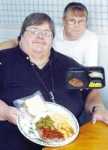Surgery reduces man's weight, provides new outlook on life

DIEHLSTADT -- Like millions of Americans, Bobby Burns of Diehlstadt has struggled with weight all of his life, but when his 500-plus pound body started to take over his life, Burns decided to fight back.
The 54-year-old underwent gastric bypass surgery in March to make his stomach smaller. Seven weeks later -- and 51 pounds lighter -- Burns feels like a new man.
"I'm excited," Burns said. "I feel like I've got a new life, and I've lost most interest in eating. I used to live to eat. Now I eat to live."
Prior to his surgery, Burns had been depressed, kept a low-profile and was about to give up on his life, he said.
"I decided I had to do something about my weight," Burns noted.
Burns found an outlet after navigating the Web site, ObesityHelp.com. It was there learned about a bariatric surgeon (those who perform gastric bypasses) Phillip Hornbostel, who was located in Sedalia.
Within weeks, Hornbostel's office contacted Burns and met with him to set up the surgery. Prior to the surgery, Burns had to attend a seminar about the procedure that was going to be done on him called Roux-en Y gastric bypass, or RUNY.
With a RUNY, a portion of the stomach is closed off, leaving a small "pouch" to hold food and restrict the amount of food that can be eaten at one time. The small intestine is cut and then reattached to the new stomach pouch, leaving a shortened path for food to travel. Because part of the small intestine is bypassed, less food is absorbed.
"After it was over, I thought 'What in the world have I done?'" Burns recalled.
Seven small scars the size of a nickel on Burns' stomach are the only signs of the surgery since it was done laparoscopically.
Burns' obesity stems from his childhood he said, but the turning point came in February 2003 when Burns reached his highest weight at 587 pounds. After following the Atkins diet for several months, Burns dropped to 521 pounds a year later. He lost an additional 23 pounds before his surgery March 8 when he weighed in at 498 pounds. As of April 20, Burns weighs around 440 pounds.
"It's especially noticeable around my face," Burns said about the weight loss. "I've been wearing pants and shirts I haven't worn in seven or eight years."
Part of Burns' post-op included a consultation with a nutritionist. With his new "pouch," health officials recommended Burns eat six small portions of food a day.
So Burns went from eating half of a chicken and some potatoes to half a can of soup for meal. His eating habits and tastes have also changed, he said.
"Right now, I'm in the process of determining what I like and what I can handle and tolerate. I'm eating small portions slow. It takes about 10 or 15 minutes to eat a chicken nugget," Burns explained.
And if Burns would eat something he shouldn't, his body will definitely let him know, he said, adding that patients will go into what is called a "dumping syndrome."
"If you eat something you're not supposed to, especially with carbs, sugar or anything foreign gets into the lower intestine, it can cause nausea, vomiting, sweats or a high heart rate," Burns explained.
Burns must also drink 64 ounces of water a day and shouldn't drink carbonated beverages because it can stretch his pouch. In addition, Burns must take a vitamin B-12 and calcium with Vitamin D supplement and multi-vitamin supplements for the rest of his life.
Burns' medications have also decreased 90 percent due to his weight loss. Before the operation, Burns was taking three blood pressure medicines, two nerve medicines and three pain medications. Now he's taking one blood pressure medicine, his vitamins and a pain pill.
Burns' average weight loss per month is 35 pounds, and he would be happy to reach his ultimate goal of 225 pounds. "I don't think I'll ever be skinny mini. It's the quality of life for future and health that matters most," Burns said.
While it's only been two months, Burns already feels good about himself again and longs for the days to play with his three grandchildren and take a vacation with his wife, Linda, who said her husband is a much happier person since the procedure.
Once thought of as a surgery only for celebrities like Carnie Wilson, Al Roker and Randy Jackson, Burns pointed out gastric bypasses are becoming more and more popular.
In fact, Burns said he knows of at least a dozen people in the area -- and probably more -- who have had the same surgery he had and would like to form some sort of support group since the closest group is in Sedalia.
"If there are people out there worried about what they can do, I'm here to say don't give up," Burns said.
For Burns, the gastric bypass was the best choice for him, he said, and recommends it to anyone in the same position as him.
"Doctors are realizing more and more that obesity is a health problem. It's a hereditary and chemical thing. I want people out there to know that there is hope."
Burns admits he has a long way to go to reaching his goal, but said he has no doubt he will achieve it. He reasoned: "At least I can see the light in the tunnel, and I'm looking for good things to come in the future."
Area gastric bypass patients looking to form a support group can contact Burns via e-mail at burnsblburns@aol.com or for more information about gastric bypasses, visit the Obesity Help Web site at ObesityHelp.com.

